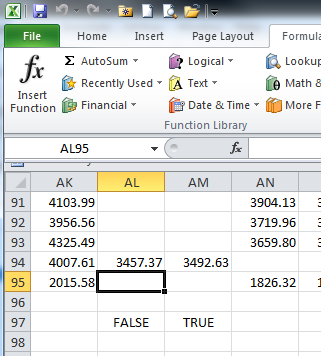- Home
- /
- Programming
- /
- SAS Procedures
- /
- PROC IMPORT: Excel spreadsheet is numeric, but reading in as character...
- RSS Feed
- Mark Topic as New
- Mark Topic as Read
- Float this Topic for Current User
- Bookmark
- Subscribe
- Mute
- Printer Friendly Page
- Mark as New
- Bookmark
- Subscribe
- Mute
- RSS Feed
- Permalink
- Report Inappropriate Content
I've received a spreadsheet that is formatted entirely as numeric data, but when I use PROC IMPORT, SAS is reading in some of these columns as character. I can't figure out why it's doing this at all. There are a fair amount of empty cells in this spreadsheet, but I have two columns that have the exact same rows that are missing, and one column has been read into SAS as numeric and the other as character. I saved the spreadsheet as a tab-delimited file & imported that instead, but it's bugging me that I had this problem in the first place. Does anyone have any ideas what might have happened? The spreadsheet's from MS Excel 2010, and I am using SAS v9.2.
Thanks!
- Mark as New
- Bookmark
- Subscribe
- Mute
- RSS Feed
- Permalink
- Report Inappropriate Content
That is strange...have you tried find and replac[ing] the empty fileds with 0's and then PROC IMPORT?
- Mark as New
- Bookmark
- Subscribe
- Mute
- RSS Feed
- Permalink
- Report Inappropriate Content
That's an interesting idea, but I don't think that that's a solution for me with this data. 0 is a legitimate value for these data, and the blank cells indicate that data are not available for a given observation.
Thanks anyway!
- Mark as New
- Bookmark
- Subscribe
- Mute
- RSS Feed
- Permalink
- Report Inappropriate Content
It that case, my guess is that you could possibly have character data on the spreadhseet...See if you can run the ANYALPHA() function on the columns to see what it's getting hung up on.
- Mark as New
- Bookmark
- Subscribe
- Mute
- RSS Feed
- Permalink
- Report Inappropriate Content
Other options to search for are ANYPUNCT() for punctuation and ANYSPACE() for white space...
- Mark as New
- Bookmark
- Subscribe
- Mute
- RSS Feed
- Permalink
- Report Inappropriate Content
Hi,
the cells with missing value are defined as text in excel. highlight the column then select clear format in excel you would see the cells with type=text. please check the attached file. I had the same problem a few days ago.

- Mark as New
- Bookmark
- Subscribe
- Mute
- RSS Feed
- Permalink
- Report Inappropriate Content
This is normal behavior for Excel. It is discussed every couple of months in SAS circles. See https://communities.sas.com/message/128876#128876.
Since your data is all numbers saving it to a CSV or other text format sounds like the best solution to me.
Remember that Excel is NOT a database system. In Excel each cell is independent.
- Mark as New
- Bookmark
- Subscribe
- Mute
- RSS Feed
- Permalink
- Report Inappropriate Content
The ANYCHAR and ANYSPACE functions have been helpful. Both of them are saying there is no hidden character data. I took another look in the excel spreadsheet, and it looks like even though it looks like the cell is blank, it isn't actually blank. The ISBLANK() function in excel is returning false (the two examples are running off of row 95). Apparently I need to talk to the person who sent me this file to find out how this file was generated - clearly there's something going on in the background.
Thanks for all the suggestions!
- Mark as New
- Bookmark
- Subscribe
- Mute
- RSS Feed
- Permalink
- Report Inappropriate Content
Here is a simple trick to avoid this problem.
Usually when importing data from Excel or csv, SAS decide whether variable type should be numeric or character while reading the first few rows of the dataset.
As a trick, you can insert a new row into your input Excel file after the label row and assign value 9999 for all numeric columns and 'aaaa' for all character columns and then import into SAS. After you import delete this additional row from the dataset.
Good luck for your dataset!
April 27 – 30 | Gaylord Texan | Grapevine, Texas
Registration is open
Walk in ready to learn. Walk out ready to deliver. This is the data and AI conference you can't afford to miss.
Register now and lock in 2025 pricing—just $495!
Learn the difference between classical and Bayesian statistical approaches and see a few PROC examples to perform Bayesian analysis in this video.
Find more tutorials on the SAS Users YouTube channel.
SAS Training: Just a Click Away
Ready to level-up your skills? Choose your own adventure.



